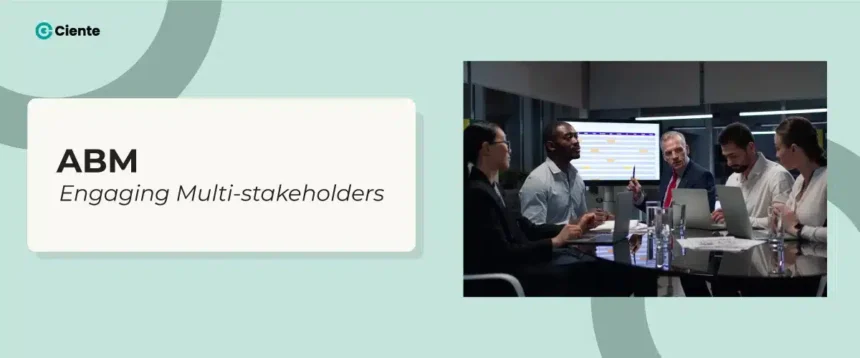Meta: ABM is often misunderstood. It’s touted as a magic wand. It’s not. It’s so much more.
You’ve heard ABM campaigns work and that they’ll fix your pipeline problems.
Gartner reported in 2021 that programs that assign 32% of their budget to ABM campaigns had a high-quality pipeline.
Yet, many have found that their ABM campaigns are not working. And you’ve done all of it— identified accounts interested in offers similar to yours, accounts with intent, and everything a good ABM practice should entail.
But it just doesn’t work. Where are the high-quality pipelines that the statistics had promised you?
Leads are still down.
Marketing campaigns are still not reaching their audience. But trust in ABM is at an all-time high.
Why wouldn’t it be? It’s an effective way. But only when done right.
Businesses are missing a vital piece of the ABM puzzle: the multiple stakeholders.
Stakeholders and decision-makers have a list. And perhaps, you’re not on it.
The accounts you’re targeting have a committee of around 11 buyers (on average). These decision-makers, like most people, have vested interests that they wish to achieve from the sale. Maybe the CSO wants a tool with better security and integration. The CTO wants a tool that seamlessly collects and collates data.
There are many cases where the committee will want different things. But they’re working for one common goal: The organization’s profits.
To keep their vested interests protected and ensure organizational growth, the buyers come to a compromise— they create a list of vendors they would want to work with. This list is a shared one.
And as HBR puts it, 90% of the buyers buy from this list.
Even if you use ABM, if you’re not on the list, your tactics are going to be futile.
The solution is straightforward.
Multi-stakeholder engagement is the secret recipe to ABM.
Now that the secret’s out. What can you do about it?
ABM is not easy.
It’s resource-intensive, requires personalization, and a molecular understanding of the buyers. This is where most teams mess up.
ABM is not what the blogs are telling you— they lack depth and nuance to explain a complex process. And the fulcrum of this process lies in multi-stakeholder engagement.
Your first step for ABM is to understand if your budget allows for it. A chat with your finance team comes way before strategy and planning.
If yes, then
Identification
- You must discover your high-value accounts.
- What problem is your product solving?
- Why is it solving it?
- How?
When you answer simple (yet multi-faceted) questions like these, you understand what market you’re catering to and the specific gaps you solve.
Once you have that, you have your high-value accounts.
- In comes intent.
You can either use tools like 6Sense, Bombora, or an agency like your very own Ciente to discover the intent behind these accounts.
- Are they actively looking for solutions?
- Why?
But now comes the tricky part— competition and the list play a huge part in this.
Whatever solution you’re solving probably has industry leaders or a fair amount of competition. Your accounts/buyers are so self-aware that they know about the risks in their industry before even knowing about your solution.
That list helps them narrow down the options. And it is this list that you must influence.
There are a lot of conversations regarding ABM, but the one mistake everyone seems to make is not understanding that it isn’t a plan but a strategy to create a ripple effect. And that takes time. Quite a lot of it. For a successful ABM campaign, you have to start by engaging the buying committee. And how will you know who’s on it?
Spray and pray?
Two Methods
In a conversation with our CMO, the marketing team asked her: What actually runs the ABM campaign? Can you identify the stakeholders without talking to someone in the organization?
The answer she gave drives our conversations here. She said, “It’s not the person who visits the website a few times. That’s just interest. But if you see a whole group of people on your website or product listing and they’re from the same organization, you can bet some of those are going to be decision-makers or at least people in the know-how. We can start there.”
That’s the first one. The second one is a bit simpler but a bit on the expensive side.
Essentially, you will be running a campaign on your account. To everyone. The C-suites. The directors. The board.
This data is public knowledge. But that does not mean you just start blasting them with messages; your campaigns should reflect the role of the people involved and the specific problem you solve for them. From your email marketing campaigns and ads to informational content, all of it will be focused, in some way, to cater to your accounts’ needs.
This is resource-heavy because it requires hyper-personalization. This is what the successful ABM campaigns you hear about are doing.
Sales’ Role
Without your sales team’s active involvement, your engagement strategy is bound to fail. At the end of the day, no matter what the ABM campaign does, your SDRs must convey the same energy.
The faltering of your promise or over-promising something that does not exist will not be good for your sales teams. Ideally, after an ABM campaign, you would want them to call you.
But, ideal scenarios rarely pan out; there will be moments where your SDRs will have to call multiple people at the same time. They will have to ensure brand voice and understand the problem.
And they have to be savvy enough to have a conversation with them instead of pushing for an aggressive sell. As they will be engaging people who share common information and communication space, their job would be to: –
- Create goodwill and trust.
- Foster relationships
- Act as consultants
The great news is that your sales teams know buyers better than marketing teams. All the marketing department needs to do is give them brand guidelines— the perception you want to display.
The rest is up to them. And seldom sales team fail at that.
As their support, you will have to: –
- Craft sales enablement
- Create brand guidelines – think TOV but personalized for the sales team.
- Highlights of the product
- Product demos and all relevant material.
As you work your way through ABM, you will realize.
ABM will not be a fix if you get stuck in rigidity.
There are a lot of ABM playbooks out there. The marketing noise, as the industry calls it. From ABA to personalization-at-scale, there are a lot of plays marketers are vying for.
But the industry needs to wake up to reality— the rigidity is not working. Either marketing is high art or it’s a thing to over-optimize.
Some traditional methods still work irrespective of what gurus say, and the converse is also true. But what’s not working is playing it safe.
And ABM does not work on safety. It is risk and wallet-intensive. ABM is the hunt, and make no mistake, the multiple stakeholders of any given account are your trophies.

















